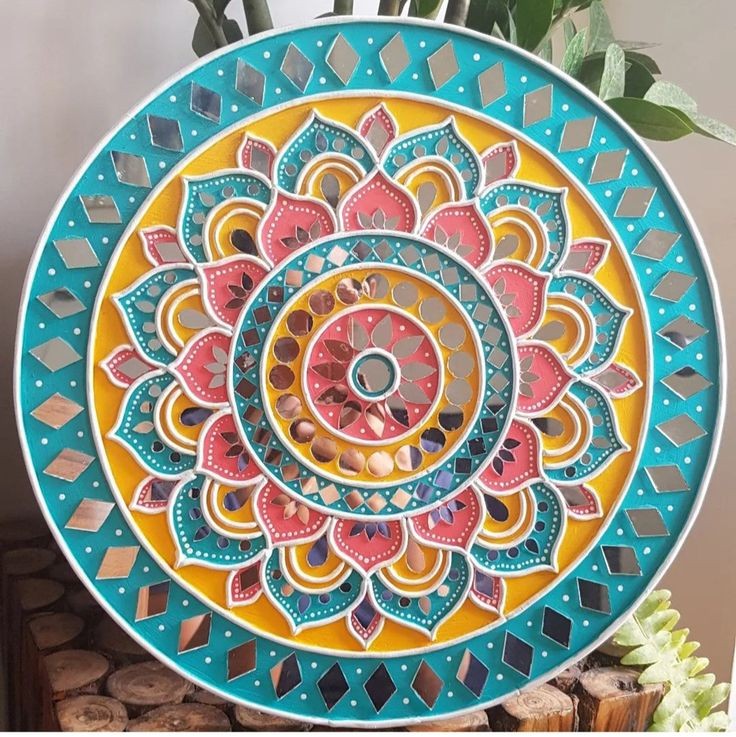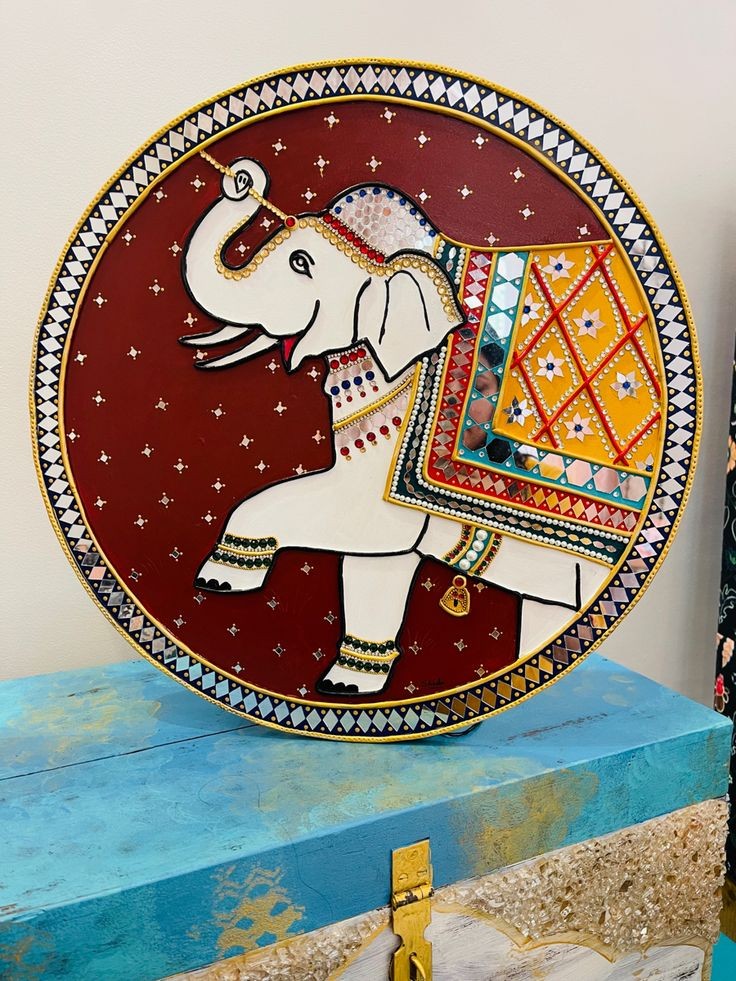Welcome to the fascinating world of Lippan art! If you’ve never heard of this mesmerizing craft before, you’re in for a treat. Lippan art, also known as Mud and Mirror Work, is a traditional Indian art form originating from the Kutch region in Gujarat. It’s a beautiful blend of creativity and cultural heritage, and it deserves to be celebrated and explored.
What is Lippan Art?
Lippan art is an intricate form of mural painting that uses a mixture of mud and mirrors to create stunning designs on walls. The word “Lippan” means clay or mud, which forms the base of this unique artwork. Historically, this art was used by the Rabari community to decorate their homes, especially the walls of their mud huts, known as Bhungas.

The Origins and History of this Art
Lippan art dates back centuries, with its roots deeply embedded in the cultural fabric of the Kutch region. The Rabari community, traditionally a nomadic tribe, are considered the original practitioners of this art form. They would adorn the interior and exterior walls of their homes with Lippan art, not only to beautify their surroundings but also to bring in a sense of peace and prosperity.
Traditionally, the women of the community were the primary artists. They would create patterns inspired by nature, such as flowers, peacocks, and camels, which are significant in their culture. Over time, Lippan art has evolved and gained popularity, moving beyond the confines of rural Kutch to urban spaces and even international platforms.
The Materials and Process
Creating Lippan art is a labor of love. The process begins with preparing the surface. Traditionally, a mixture of mud and cow dung is applied to the walls to create a base. Once the base is ready, the artists use their hands to shape and smooth the mud, creating intricate patterns and designs.
The next step involves embedding mirrors into the mud. These mirrors, called “Abhala,” are cut into various shapes and sizes. The placement of these mirrors is crucial as they catch the light and create a sparkling effect, bringing the artwork to life.
The process requires patience and precision. Each design is carefully crafted, and the mirrors are delicately placed to enhance the overall beauty of the artwork. The final result is a stunning piece of art that reflects light and adds a touch of elegance to any space.
Recommended Materials
For those interested in creating Lippan art at home or incorporating it into their modern decor, here are some recommended materials:
- Base Material: While traditional Lippan art uses a mixture of mud and cow dung, you can use air-dry clay, which is easier to work with and more accessible. Polymer clay is another option for a durable base.
- Mirrors: You can purchase small, decorative mirrors online or at craft stores. Look for mirrors that come in various shapes like circles, squares, and triangles to add diversity to your design.
- Adhesive: A strong adhesive is essential to secure the mirrors onto the clay. Epoxy glue or a high-quality craft glue works well for this purpose.
- Tools: Basic sculpting tools, such as spatulas, rollers, and cutters, will help you shape and smooth the clay. These tools are readily available at craft stores.
- Surface Preparation: If you’re working on a wall, ensure it is clean and primed before applying the clay. For smaller projects, you can use a wooden or canvas board as your base.
- Paints and Finishes: Acrylic paints can add color to your art. Use metallic or pearl finishes to mimic the traditional look. Seal your artwork with a clear varnish to protect it and enhance its longevity.
- Design Templates: For beginners, design templates or stencils can be very helpful. These templates can guide you in creating symmetrical and intricate patterns.

Modern Adaptations of Lippan Art
While traditional Lippan art is confined to walls, modern adaptations have taken this art form to new heights. Contemporary artists and designers are experimenting with Lippan art on various surfaces, including wood, canvas, and even furniture. This evolution has made Lippan art more accessible and versatile, allowing it to be incorporated into modern interiors.
Today, you can find this art in homes, offices, hotels, and art galleries. It has become a popular choice for interior decoration, adding a unique touch of Indian heritage to any space. Many artists are also incorporating different colors and materials into their designs, giving Lippan art a fresh and contemporary look.
The Cultural Significance of this Art
Lippan art is more than just a form of decoration; it is a reflection of the cultural heritage and traditions of the Kutch region. Each design tells a story, representing the beliefs, customs, and way of life of the people who create it. The use of natural elements and motifs in Lippan art signifies the deep connection the Rabari community has with nature.
Moreover, Lippan art has a spiritual aspect. The mirrors used in the artwork are believed to ward off evil spirits and bring good luck and prosperity to the household. This belief adds an extra layer of significance to the art form, making it an integral part of the community’s cultural and spiritual practices.
Why Lippan Art is Gaining Popularity
In recent years, Lippan art has gained popularity beyond the Kutch region, attracting art lovers and collectors from around the world. There are several reasons for this growing interest:
- Aesthetic Appeal: The intricate designs and the play of light created by the mirrors make Lippan art visually captivating. It adds a unique and exotic touch to any space, making it a favorite among interior designers.
- Cultural Connection: As people become more interested in preserving and celebrating cultural heritage, traditional art forms like Lippan art are gaining recognition and appreciation.
- Versatility: Modern adaptations of Lippan art have made it versatile and suitable for various surfaces and spaces. This flexibility allows it to be used in diverse settings, from traditional homes to contemporary offices.
- Handmade Craftsmanship: In an age where mass-produced items are the norm, the handmade nature of Lippan art stands out. Each piece is unique and carries the personal touch of the artist, making it special and valuable.
How to Incorporate this Art into Your Space
If you’re inspired by the beauty of this art and want to incorporate it into your space, here are a few ideas:
- Wall Panels: Use Lippan art panels as a focal point on a wall. Whether it’s in your living room, bedroom, or office, these panels can add a touch of elegance and cultural charm.
- Furniture: Look for furniture pieces that feature this art. Coffee tables, cabinets, and headboards with Lippan art detailing can be stunning additions to your decor.
- Home Accessories: Incorporate smaller art pieces, such as mirrors, picture frames, and wall hangings, to add subtle yet beautiful accents to your space.
- DIY Projects: If you’re feeling creative, try your hand at making your own art. There are kits and workshops available that can guide you through the process, allowing you to create a personalized piece of art.

Preserving the Tradition
As Lippan art continues to gain popularity, it’s essential to ensure that the traditional techniques and knowledge are preserved. Efforts are being made to document and promote the art form, providing training and support to artisans in the Kutch region. By supporting local artists and purchasing authentic Lippan art, you can contribute to preserving this beautiful tradition for future generations.
In conclusion, Lippan art is a remarkable and enchanting art form that beautifully blends creativity, culture, and tradition. Its intricate designs and sparkling mirrors make it a unique and captivating addition to any space. Whether you’re an art enthusiast, a decorator, or someone who appreciates cultural heritage, Lippan art offers a timeless charm that is sure to inspire and delight. So, why not bring a piece of this mesmerizing art into your home and experience the beauty of Lippan art for yourself?
Table of Contents
-
Lippan art: 4 better techniques to master it!
Welcome to the fascinating world of Lippan art! If you’ve never heard of this mesmerizing craft before, you’re in for a treat. Lippan art, also known as Mud and Mirror Work, is a traditional Indian art form originating from the Kutch region in Gujarat. It’s a beautiful blend of creativity and cultural heritage, and it…
-
Resin Art: Know the 5 better techniques to master it
Resin art is an exciting and creative hobby that lets you make beautiful, shiny, and colorful artworks. From coasters and jewelry to wall art and furniture, resin can be used to create stunning pieces. If you’re new to resin art, don’t worry! This guide will help you get started with simple steps and tips. What…
-
Doodle Art: 7 better hacks to create it!
Hello and welcome to my blog! Today, we’re going to dive into the delightful world of doodle art. Whether you’re an experienced artist or someone who enjoys scribbling in the margins of your notebook, doodle art offers a fun and relaxing way to express your creativity. Let’s explore what doodle art is, its benefits, the…
Follow Artup for more art related ideas/blogs💡